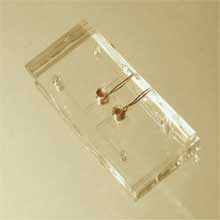Rapid TB Detector
One third of the world’s population is infected with tuberculosis. Detecting the bacteria is time-consuming and expensive, even in hospitals with sophisticated lab equipment. And in the poor countries where the infection is most prevalent, people often don’t have access to this equipment. Researchers at Massachusetts General Hospital in Boston and Harvard University have now demonstrated that a handheld device can be used to count as few as 20 bacteria in a sputum sample in a half hour. They hope to develop the test into an inexpensive product that can be deployed for TB testing.

The bacteria counter is being developed by researchers led by Ralph Weissleder, director of the Center for Systems Biology and the Center for Molecular Imaging Research at Harvard Medical School, and Hakho Lee, an instructor at Mass General. The technology uses magnetic-nanoparticle labels and a detector that works on the same principles as magnetic resonance imaging. They’re focused on tuberculosis, says Lee, because “even one bacterium can cause the disease, but at this point there is no easy way to detect the bacteria at high sensitivity.”
The biggest problem with existing tests is that they are too slow, says Peter Katona, associate clinical professor of infectious diseases at the University of California, Los Angeles. The most accurate way to identify the infection is to grow a sample in the lab. But because TB grows slowly, that can take as long as six weeks. What’s more, expensive culture equipment is typically not available in poor areas where the infection is prevalent.
The cheapest and fastest way to detect TB is a skin test that screens for an immune reaction. But such tests are not particularly accurate. “There are a number of conditions where there is no immune reaction” even if the patient carries the infection, says Steven Miller, director of the clinical laboratories at the University of California, San Francisco Medical Center. TB and HIV often go hand in hand, but in HIV-positive patients the skin test doesn’t work. Another common test, staining a sputum sample with a dye that targets TB and examining it under the microscope, also has a high rate of false negatives. “Unless there is a very high load of bacteria, you can’t pick it up,” says Miller.
The Harvard detector can find very small loads of bacteria. It’s a miniaturized version of a nuclear magnetic resonance imager, a very sensitive but typically large and expensive device used for clinical and chemical applications such as brain imaging and determining protein structures. The size and expense of typical nuclear magnetic resonance imagers is dictated by the need for a strong magnet. Weissleder’s group simplified the instrument into a portable, one-pound device with disposable parts by compromising on signal quality and by placing the sample chamber right inside the radio-frequency coils. “When you’re measuring bacteria, you don’t need high resolution–you just need to pick up one pattern,” says Lee.
As proof of principle, Weissleder and Lee demonstrated they could detect a bacterium very similar to tuberculosis in sputum samples. First, the viscous sample must be liquefied. Then it’s mixed with a solution of cannonball-shaped iron nanoparticles coated in antibodies that stick to the bacteria. The sample is loaded onto the detector, which uses microfluidics to force the sample through a channel fitted with a screen that traps bacteria and washes free any nanoparticles that didn’t meet a target. This channel is surrounded by a metal coil that pulses the trapped bacteria with radio-frequency waves under the influence of a magnet. This causes the iron nanoparticles to emit a magnetic signal, in turn affecting the protons in the surrounding water molecules. The Harvard device picks up on these changes, whose magnitude and duration are directly proportional to the number of labeled bacteria in the sample.
The bacteria detection process takes about 30 minutes and is as sensitive as processes that use culture samples grown in the lab. The results are described in the journal Angewandte Chemie.
“Trying to diagnose very low levels of bacteria in a sample while maintaining high quality is not an easy thing to do,” says pathologist Miller. The Harvard test is very sensitive–that is, it can detect low levels of bacteria–but until the device undergoes more tests, it’s impossible to say how specific it is. If it proves to have high rates of false positives, says Miller, it won’t be viable in places like the United States, where tuberculosis rates are low. However, says Miller, “there could be a lot of value for a cheap and easy test like this in areas with high tuberculosis prevalence.”
The researchers are collaborating with the Harvard School of Public Health to test the device on clinical samples from patients carrying tuberculosis.
Keep Reading
Most Popular
Large language models can do jaw-dropping things. But nobody knows exactly why.
And that's a problem. Figuring it out is one of the biggest scientific puzzles of our time and a crucial step towards controlling more powerful future models.
The problem with plug-in hybrids? Their drivers.
Plug-in hybrids are often sold as a transition to EVs, but new data from Europe shows we’re still underestimating the emissions they produce.
Google DeepMind’s new generative model makes Super Mario–like games from scratch
Genie learns how to control games by watching hours and hours of video. It could help train next-gen robots too.
How scientists traced a mysterious covid case back to six toilets
When wastewater surveillance turns into a hunt for a single infected individual, the ethics get tricky.
Stay connected
Get the latest updates from
MIT Technology Review
Discover special offers, top stories, upcoming events, and more.